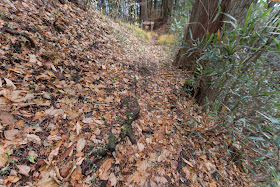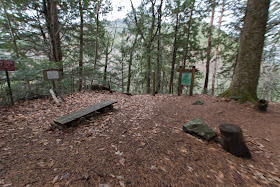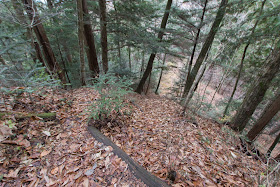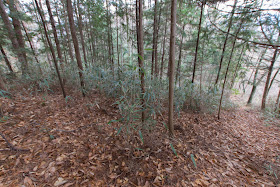Fukushima Castle (Kiso)
-Sacrifice for Survival-
Overview
Name: Fukushima castle (Fukushima-jo)
Alias:
Place: Fukushima Kiso town, Nagano
Location: 35.85508361232177, 137.69258329670402
Type: Mountain Castle
Built: 15th century
Remaining remnants: Clay walls and dry moats
Title:
Fukushima castle (福島城, to distinguish from other same name castle it is often called as Kiso Fukushima castle) is located on the ridge of Shiroyama mountain, one of about 200 meter height from hillside at the backside of current Fukushima town, which is the center of Kiso valley.
Kiso valley is a 80 kilometer long one between Kiso mountains and Hida mountains, connecting Shiojiri area at the south edge of Matumoto basin of Nagano prefecture and Nakatsugawa area at the east edge of Nobi plain of Gifu prefecture. It consists of north part of one third length formed by Narai-gawa river, and south part of two third length runs along Kiso-gawa river.
Because of its geographical condition, Kiso valley has been one of the important roads connects east part and west part of Japan. At first ancient Tozando road crosses Misaka toge pass and ran Ina valley ahead of Kiso mountains, but considering hardship of Misaka toge pass, later Kiso valley ws developped as an artery.
In Edo era, Nakasendo road which was one of five major roads run Kiso valley, and posting town of the road such as Narai town or Magome town still kept atmosphere of that period. Today there is no highway but railroad and Route 19 parallelly run in the narrow valley and conveys many passengers and items.
Fukushima castle was built in the beginning of 15th century by local lord Kiso clan. In 12th century, just before the establishment of Kamakura Shogunate by Yoritomo Minamoto (1147-1199), his cousin Yoshinaka Minamoto (1154-1184) who was hided from Taira clan grew in Kiso valley then known as Yoshinaka Kiso.
In 1180, Yoshinaka raised his army against Taira clan and broke Takra army at Hokuriku region in the battle of Kurikara-Toge pass. Yoshinaka once entered Kyoto city ahead of the army of Yoritomo Minamoto, but failed to keep security and supply of the capital city then broke with the Imperial Household then was finally broken by the army of Yoshitune Minamoto (1159-1189), the young brother of Yoritoo, and died in the battlefield.
After that the name of Kiso clan disappdared from the history for the while, then apperaed in 14th century again. This Kiso clan insisted that they were descendants of Yoshinaka Kiso, but it is thought that this newer Kiso clan was a descendant of Numata clan at current Numata city of Gunma prefecture and entered Kiso valley under the order of Muromachi Shogunate.
By the end of 14th century, this Kiso clan seized whole part of Kiso valley, and placed their branch family throughout the valley. As Kiso valley is surrounded by deep mountains and further expansion is difficult, Kiso clan seeked developent of economy by building road passing the valley and selling timbers produced from mountains. Around this time Kiso Fukushima castle was built as the main base of the clan.
In the beginning of 16th century, Kiso clan became one of four major local lords of Shinano province (Nagano prefecture), along with Ogasawara clan at Matsumoto area, Murakami clan at Chiisagata area and Suwa clan at Suwa area. But since 1540 Shingen Takeda (1521-1573), the warlord of Kai province (Yamanashi prefecture), started invation toward Shinano province.
Shingen ruined Suwa clan and Ogasawara clan, then expelled Murakami clan then faced the army of Kenshin Uesugi (1530-1578), the warlord of Echigo province (Niigata prefecture) who supported Murakami clan at Kawanakajima area in current Nagano city. To concentrate its army toward Uesugi clan, it was necessary to cope with Kiso clan which still remained at backside.
In 1555, at last Shingen attack ed Kiso clan. Yoshiyasu Kiso (1514-1579) at first broke Takeda army at Torii-Toge pass but was broken at next battle then finally surrendered to Takeda clan. Yoshiyasu let his son Yoshimasa Kiso (1540-1595?) marry with the daughter of Shingen and was treated as relative of Takeda clan.
Because of the limited population and army, Kiso clan basically did not participate in the battles of Shingen then offered supplies and fund to Takeda army. In the latter half of 1560's Shingen aggressively expanded into Hida province (northeast part of Gifu prefecture) or Mino province (Gifu prefecture), and Kiso valley became supply base to such front.
In 1572, Shingen started his operation against an ally of central ruler of Nobunaga Oda (1534-1582) and Ieyasu Tokugawa (1543-1616). Shingen captured Iwamura castle (Gifu prefecture) from Oda clan, and broke Tokugawa army at the battle of Mikatagahara. But on the way Shingen died in ill, then Takeda army returned to Kai province.
Katsuyori Takeda (1546-1582), who was the son and successor of Shingen, aggresssively attacked Oda clan and Tokugawa clan again. But Katsuyori suffered fetal defeat in the battle of Nagashino before Nobunaga and Ieyasu, and lost many generals and soldiers. The military power of Takeda clan significantly declined, then the clan started to fall.
Looking at this opportunity, Nobunaga and Ieyasu attacked castles deprived by Takeda clan. Tokugawa army recovered Futamata castle (Shizuoka prefecture), and Oda army firmly encirled Iwamura castle (Gifu prefecture) near from Kiso valley. Katsuyori ordered Yoshimasa Kiso to support Iwamura castle and also sent his army to support, but finally the castle fell and its commander Torashige Akiyama (1527-1575) was executed.
Due to the loss of Takeda territory in Mino province, Kiso valley had to face superior Oda army with small troops. Yoshimasa Kiso strengthened Kiso Fukushima castle for defense, but plot of Oda clan to trun Kiso clan started thus Katsuyori Takeda ordered the retainer of Kiso clan to watch Yoshimasa Kiso.
Fukushima castle was built utilizing narrow ridge between sheer slope and valleys. Central area of the castle is a oblong shaped one of about 50 meter long and 20 meter wide, with a small entrance area from secondary area ahead of dry moat. Backside of central area is protected by combination of small terraces and dry moats.
At the south of central area, secondary area and third area straightly stands along the ridge. Secondary area is a small round shaped one of about 20 meter diameter, and third area is a narrow and long one onf about 60 meter long and 10 meter wide. Three core areas are separated by dry moat, and central area and secondary rea is wholly surrounded by corridor area.
Total size of the castle is about 300 meter long and 50 meter wide, and because of narrow ground defense facilities other than dry moat were not built. Hillside residence of Kiso clan existed at the river terrace opposite of the river now used as the ground of high school.
Katsuyori Takeda kept desperate resistance against Oda arny and Tokugawa army, but lost many castles and especially could not help Takatejin castle (Shizuoka prefecture) in 1581 and lost the support of retainers. Nobunaga planned total attack to Takeda clan and strengthened plot to Kiso clan.
In the beginning of 1582, Yoshimasa Kiso finally turned to Oda clan for survival. Son, daughter and mother of Yoshimasa kept as hostage at Takeda clan were executed, and Katsuyori lead large army to Suwa area to attack Kiso clan. Takeda army fought against Kiso army at Torii-Toge pass, but being supported by the terrain and reinforcement army from Oda clan, Kiso army defeated Takeda army.
At the same time, Nobunaga Anayama (1541-1582), another relative of Takeda clan and lord of Suruga province, also turned to Tokugawa army and let them enter into Kai province. As the defense line of Takeda clan was built at Ina valley toward south, change of Kiso clan and Anayama clan was unexpected accident and resistance of Takeda clan completely collapsed.
Finally Katsuyori killed himself at the place of Tano only one month after the turn of Kiso clan, and former Takeda territory was captured by Nobunaga and Ieyasu. Nobunaga highly evaluated Kiso clan which made opportunity to ruin Takeda clan losing their family, and gave current Matsumoto area to Yoshimasa in addition to Kiso valley. It seemed Yoshimasa could survive and be rewarded, losing important families.
However, just 3 month after the end of Takeda clan, this time Oda goverment collapsed by the loss of Nobunaga in the incident of Honnoji, a coup d'etat by his general Mitsuhide Akechi (1528-1582). Utilizing the confusion Yoshimasa tried to expand his territory, but by the raise of Ogasawara clan which formerly held Matsumoto area, Kiso clan lost the area and had to return to Kiso valley.
Furthrmore, Kiso clan once belonged to Ieyasu Tokugawa who seized Kai province and Shinano province but was involved in the conflict between Ieyasu and next ruler Hideyoshi Toyotomi (1537-1598). At this battle Yoshimasa turned to Hideyoshi along with Ogasawara clan, but Hideyoshi and Ieyasu agreed then Kiso clan returned to the subordinate of Ieyasu with bad impression.
In 1590, after the fall of Hojo clan which held Kanto region, Hideyoshi ordered Ieyasu to move to former territory of Hojo clan, with its subordinate lords. As a retainer of Ieyasu, Kiso clan also had to leave familiar Kiso area to far apart Ajido area of current Chiba prefecture. Yoshimasa died in ill there, and his son was expelled being blamed trouble in 1600 then the history of Kiso clan as the warlord had ended.
At the battle of Sekigahara in 1600, Ieyasu hired Yamamura clan which was former retainer of Kiso clan to capture Kiso area, to keep communication route between Kanto region which was the territory of Tokugawa clan and Tokai region that was expected front. After the battle Yamamura clan became the magistrate of Kiso valley as a reward and managed the valley by the end of Kiso era.
Currently no building is left but structure of the castle well remain on the mountain. The shape of the castle not so large but securely guarded by deep moat and valley exactly shows the situation of Kiso valley and Kiso clan. The valley seen from the castle is the treasure of Kiso clan hoped to protect by any sacrifice but could not do so.
20 minutes walk from JR Central Chuo-Honsen line Kiso-Fukushima station to entrance of climbing road. Another 30 minutes walk to hilltop castle. 60 minutes drive from Chuo Jidoshado Expressway Nakatsugawa interchange.
Type: Mountain Castle
Built: 15th century
Remaining remnants: Clay walls and dry moats
Title:
Brief History
Fukushima castle (福島城, to distinguish from other same name castle it is often called as Kiso Fukushima castle) is located on the ridge of Shiroyama mountain, one of about 200 meter height from hillside at the backside of current Fukushima town, which is the center of Kiso valley.
Kiso valley is a 80 kilometer long one between Kiso mountains and Hida mountains, connecting Shiojiri area at the south edge of Matumoto basin of Nagano prefecture and Nakatsugawa area at the east edge of Nobi plain of Gifu prefecture. It consists of north part of one third length formed by Narai-gawa river, and south part of two third length runs along Kiso-gawa river.
Because of its geographical condition, Kiso valley has been one of the important roads connects east part and west part of Japan. At first ancient Tozando road crosses Misaka toge pass and ran Ina valley ahead of Kiso mountains, but considering hardship of Misaka toge pass, later Kiso valley ws developped as an artery.
In Edo era, Nakasendo road which was one of five major roads run Kiso valley, and posting town of the road such as Narai town or Magome town still kept atmosphere of that period. Today there is no highway but railroad and Route 19 parallelly run in the narrow valley and conveys many passengers and items.
Two Kiso clans in history
Fukushima castle was built in the beginning of 15th century by local lord Kiso clan. In 12th century, just before the establishment of Kamakura Shogunate by Yoritomo Minamoto (1147-1199), his cousin Yoshinaka Minamoto (1154-1184) who was hided from Taira clan grew in Kiso valley then known as Yoshinaka Kiso.
In 1180, Yoshinaka raised his army against Taira clan and broke Takra army at Hokuriku region in the battle of Kurikara-Toge pass. Yoshinaka once entered Kyoto city ahead of the army of Yoritomo Minamoto, but failed to keep security and supply of the capital city then broke with the Imperial Household then was finally broken by the army of Yoshitune Minamoto (1159-1189), the young brother of Yoritoo, and died in the battlefield.
After that the name of Kiso clan disappdared from the history for the while, then apperaed in 14th century again. This Kiso clan insisted that they were descendants of Yoshinaka Kiso, but it is thought that this newer Kiso clan was a descendant of Numata clan at current Numata city of Gunma prefecture and entered Kiso valley under the order of Muromachi Shogunate.
Grow to lord of valley
By the end of 14th century, this Kiso clan seized whole part of Kiso valley, and placed their branch family throughout the valley. As Kiso valley is surrounded by deep mountains and further expansion is difficult, Kiso clan seeked developent of economy by building road passing the valley and selling timbers produced from mountains. Around this time Kiso Fukushima castle was built as the main base of the clan.
In the beginning of 16th century, Kiso clan became one of four major local lords of Shinano province (Nagano prefecture), along with Ogasawara clan at Matsumoto area, Murakami clan at Chiisagata area and Suwa clan at Suwa area. But since 1540 Shingen Takeda (1521-1573), the warlord of Kai province (Yamanashi prefecture), started invation toward Shinano province.
Shingen ruined Suwa clan and Ogasawara clan, then expelled Murakami clan then faced the army of Kenshin Uesugi (1530-1578), the warlord of Echigo province (Niigata prefecture) who supported Murakami clan at Kawanakajima area in current Nagano city. To concentrate its army toward Uesugi clan, it was necessary to cope with Kiso clan which still remained at backside.
As retainer of Takeda clan
In 1555, at last Shingen attack ed Kiso clan. Yoshiyasu Kiso (1514-1579) at first broke Takeda army at Torii-Toge pass but was broken at next battle then finally surrendered to Takeda clan. Yoshiyasu let his son Yoshimasa Kiso (1540-1595?) marry with the daughter of Shingen and was treated as relative of Takeda clan.
Because of the limited population and army, Kiso clan basically did not participate in the battles of Shingen then offered supplies and fund to Takeda army. In the latter half of 1560's Shingen aggressively expanded into Hida province (northeast part of Gifu prefecture) or Mino province (Gifu prefecture), and Kiso valley became supply base to such front.
In 1572, Shingen started his operation against an ally of central ruler of Nobunaga Oda (1534-1582) and Ieyasu Tokugawa (1543-1616). Shingen captured Iwamura castle (Gifu prefecture) from Oda clan, and broke Tokugawa army at the battle of Mikatagahara. But on the way Shingen died in ill, then Takeda army returned to Kai province.
Threat approach to valley
Katsuyori Takeda (1546-1582), who was the son and successor of Shingen, aggresssively attacked Oda clan and Tokugawa clan again. But Katsuyori suffered fetal defeat in the battle of Nagashino before Nobunaga and Ieyasu, and lost many generals and soldiers. The military power of Takeda clan significantly declined, then the clan started to fall.
Looking at this opportunity, Nobunaga and Ieyasu attacked castles deprived by Takeda clan. Tokugawa army recovered Futamata castle (Shizuoka prefecture), and Oda army firmly encirled Iwamura castle (Gifu prefecture) near from Kiso valley. Katsuyori ordered Yoshimasa Kiso to support Iwamura castle and also sent his army to support, but finally the castle fell and its commander Torashige Akiyama (1527-1575) was executed.
Due to the loss of Takeda territory in Mino province, Kiso valley had to face superior Oda army with small troops. Yoshimasa Kiso strengthened Kiso Fukushima castle for defense, but plot of Oda clan to trun Kiso clan started thus Katsuyori Takeda ordered the retainer of Kiso clan to watch Yoshimasa Kiso.
Structure of Fukushima castle
Fukushima castle was built utilizing narrow ridge between sheer slope and valleys. Central area of the castle is a oblong shaped one of about 50 meter long and 20 meter wide, with a small entrance area from secondary area ahead of dry moat. Backside of central area is protected by combination of small terraces and dry moats.
At the south of central area, secondary area and third area straightly stands along the ridge. Secondary area is a small round shaped one of about 20 meter diameter, and third area is a narrow and long one onf about 60 meter long and 10 meter wide. Three core areas are separated by dry moat, and central area and secondary rea is wholly surrounded by corridor area.
Total size of the castle is about 300 meter long and 50 meter wide, and because of narrow ground defense facilities other than dry moat were not built. Hillside residence of Kiso clan existed at the river terrace opposite of the river now used as the ground of high school.
Sacrifice for survival
Katsuyori Takeda kept desperate resistance against Oda arny and Tokugawa army, but lost many castles and especially could not help Takatejin castle (Shizuoka prefecture) in 1581 and lost the support of retainers. Nobunaga planned total attack to Takeda clan and strengthened plot to Kiso clan.
In the beginning of 1582, Yoshimasa Kiso finally turned to Oda clan for survival. Son, daughter and mother of Yoshimasa kept as hostage at Takeda clan were executed, and Katsuyori lead large army to Suwa area to attack Kiso clan. Takeda army fought against Kiso army at Torii-Toge pass, but being supported by the terrain and reinforcement army from Oda clan, Kiso army defeated Takeda army.
At the same time, Nobunaga Anayama (1541-1582), another relative of Takeda clan and lord of Suruga province, also turned to Tokugawa army and let them enter into Kai province. As the defense line of Takeda clan was built at Ina valley toward south, change of Kiso clan and Anayama clan was unexpected accident and resistance of Takeda clan completely collapsed.
Unrewarded choice of Kiso clan
Finally Katsuyori killed himself at the place of Tano only one month after the turn of Kiso clan, and former Takeda territory was captured by Nobunaga and Ieyasu. Nobunaga highly evaluated Kiso clan which made opportunity to ruin Takeda clan losing their family, and gave current Matsumoto area to Yoshimasa in addition to Kiso valley. It seemed Yoshimasa could survive and be rewarded, losing important families.
However, just 3 month after the end of Takeda clan, this time Oda goverment collapsed by the loss of Nobunaga in the incident of Honnoji, a coup d'etat by his general Mitsuhide Akechi (1528-1582). Utilizing the confusion Yoshimasa tried to expand his territory, but by the raise of Ogasawara clan which formerly held Matsumoto area, Kiso clan lost the area and had to return to Kiso valley.
Furthrmore, Kiso clan once belonged to Ieyasu Tokugawa who seized Kai province and Shinano province but was involved in the conflict between Ieyasu and next ruler Hideyoshi Toyotomi (1537-1598). At this battle Yoshimasa turned to Hideyoshi along with Ogasawara clan, but Hideyoshi and Ieyasu agreed then Kiso clan returned to the subordinate of Ieyasu with bad impression.
Afterward of Kiso clan and castle
In 1590, after the fall of Hojo clan which held Kanto region, Hideyoshi ordered Ieyasu to move to former territory of Hojo clan, with its subordinate lords. As a retainer of Ieyasu, Kiso clan also had to leave familiar Kiso area to far apart Ajido area of current Chiba prefecture. Yoshimasa died in ill there, and his son was expelled being blamed trouble in 1600 then the history of Kiso clan as the warlord had ended.
At the battle of Sekigahara in 1600, Ieyasu hired Yamamura clan which was former retainer of Kiso clan to capture Kiso area, to keep communication route between Kanto region which was the territory of Tokugawa clan and Tokai region that was expected front. After the battle Yamamura clan became the magistrate of Kiso valley as a reward and managed the valley by the end of Kiso era.
Currently no building is left but structure of the castle well remain on the mountain. The shape of the castle not so large but securely guarded by deep moat and valley exactly shows the situation of Kiso valley and Kiso clan. The valley seen from the castle is the treasure of Kiso clan hoped to protect by any sacrifice but could not do so.
Access
20 minutes walk from JR Central Chuo-Honsen line Kiso-Fukushima station to entrance of climbing road. Another 30 minutes walk to hilltop castle. 60 minutes drive from Chuo Jidoshado Expressway Nakatsugawa interchange.





































































































































































































































No comments:
Post a Comment